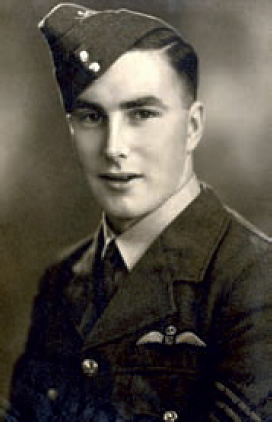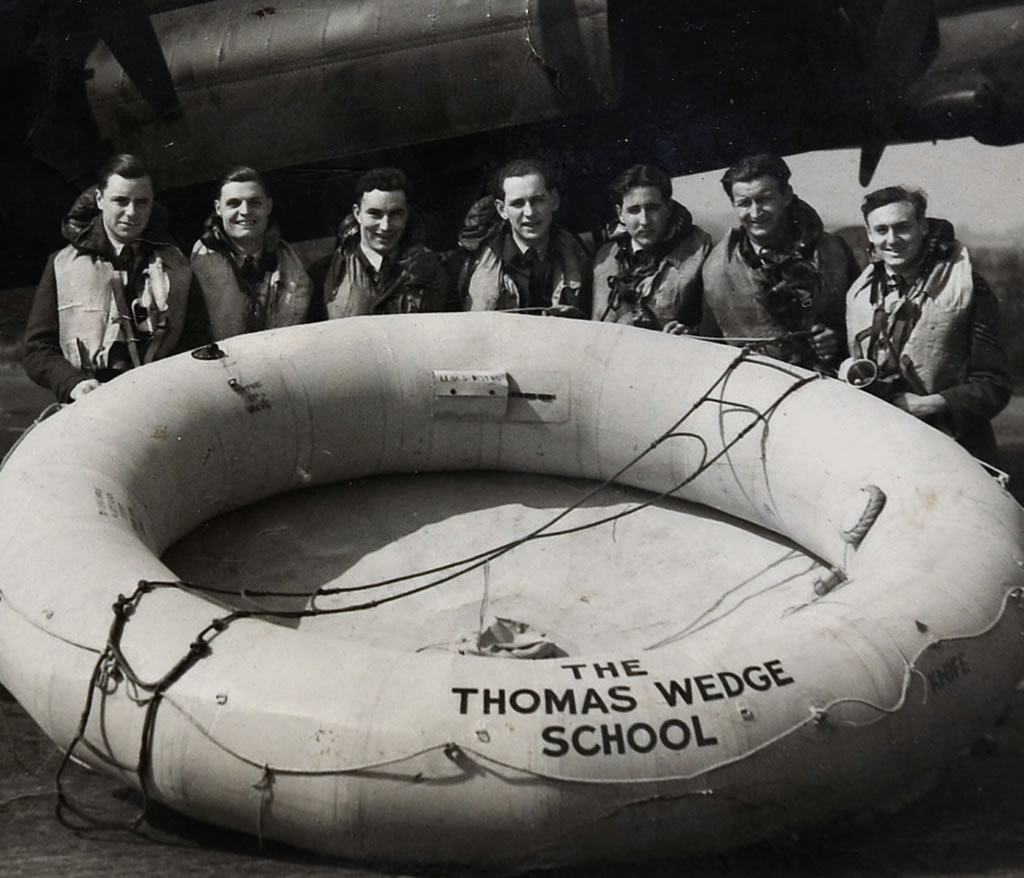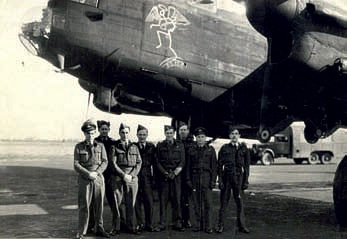While searching out info on another 75'er, Bomb Aimer A.J. "Jack" Moller, I discovered that Terry Kearns was his Pilot, both at 75 (NZ) and 156 (PFF) Squadrons, and then I found this thread.
Subsequently I (sadly) stumbled on a London auction house's catalogue from Nov 2012, listing Terry's full collection of medals, photos, letters and memorabilia for sale. It also included a full history - what an amazing career this guy had!
Noted the request for photos above, so have included one from Jack Moller's collection, courtesy of his son Tony. The information here is otherwise mostly courtesy of Spinks London - apologies for the length of the post, but not sure what you would want to leave out??!
Squadron Leader Richard Stansfield Derek Kearns, D.S.O., D.F.C., D.F.M. 
Born Reefton, New Zealand, 1920; studied Engineering at Canterbury College.
Joined Royal New Zealand Air Force, December 1940; carried out Pilot training at No.1 E.F.T.S Taieri and No.1 F.T.S. Wigram, gaining his 'Wings', 26.7.1941; arrived in England, November 1941, and undertook a refresher course at No.1 A.F.U., R.A.F. College Cranwell.
Posted to No.11 O.T.U., Bassingbourn, for conversion to Wellingtons, March 1942. Whilst at Bassingbourn Kearns formed his crew of: Navigator W.J. 'Hone' Barclay, Wireless Operator M.W. (Maurie) Egerton, and the two Gunners A.J. (Jack) Moller and H.E.A. (Buck) Price; this crew were to carry out two tours of operations together, with Kearns and Barclay flying together for most of the war.
Whilst stationed at No.23 O.T.U. the crew flew on the first 'Thousand Bomber' raid to Cologne, 30.5.1942, quickly followed by the 'Thousand Bomber' raid on Essen, 1.6.1942.
75 (NZ) SquadronPosted for operational flying to 75 (New Zealand) Squadron (Wellingtons), Feltwell, Norfolk , 17.6.1942; and carried out 25 operational sorties with the Squadron including: Emden; Bremen (3), including 25.6.1942, 'Attacked by Three ME 110s - Evasive Action Successful' (Log Book refers); St. Nazaire, 28.6.1942, 'Very Sticky Trip - 17 x 250lbs. 2 Runs on Target - Shot Down Both Times - Flak Very Accurate in Search Light Cone - Shot Up By 'E' Boats Off French Coast - Rear Gunner Slightly Wounded'; Frisian Islands (2); Wilhemshaven; Duisberg (4); Hamburg (2), including 26.7.1942, 'Load 9 S.B.C.s - Very Busy Trip - Bombs in Target Area - Brought to OFT By Flak and Searchlights & 7 Searchlights Destroyed and One Machine Gun Nest Silenced - Good Trip'; Saarbrucken (2), including 29.7.1942, 'Load 1 x 1000lb, 7 x 500lb, 2 x 250lb. Bombs in Target - No Searchlights - Flak Weak - One Ju 88 Encountered - Close Call'; Dusseldorf; Essen; Osnabruck (2); Mainz (2); Frankfurt, 24.8.1942, 'Load 9 S.B.C.s 9lb Incendaries. Flak Intense - Searchlights Poor. Attacked By F.W. 190 Evaded Successfully'; Kassel, 27.8.1942, 'Attacked By Two Enemy Fighters. Evaded Successfully'; and Nurnburg.
156 (Pathfinder Force) SquadronTransferred to 156 (Pathfinder Force) Squadron (Wellingtons and later Lancasters), Warboys, September 1942.
Pathfinder Force had been formed in August 1942, and 156 Squadron was one of the four squadrons to form the nucleus of the new force.
Kearns flew in 31 operational sorties with the Squadron including: Bremen; Wilhelmshaven (2), including 19.2.1943, 'Load 1 x 1000lb M.C. - 4 X 250 T.I. Bombs - 6 x 500lbs H.E.T. - Vis. Good - Hit By Flak Over Target - Returned on 3 Motors - E A/C Encountered Over A. - A. Photos. Very Interesting Trip - W/Op's Final Op.'; Essen (4); Saarbrucken; Krefeld; Genoa; Hamburg (2); Turin (3); Stuttgart; Mannheim; Duisburg; Munich (2); Lorient (2); Dusseldorf; Cologne; St. Nazaire (2); Berlin; Keil; La Spezia; and Pilsen (raid on Skoda Armaments Factory), 16.4.1943.

Photo: Terry Kearns (third from left) with his first crew at 156 (Pathfinder Force) Squadron, Warboys. The dinghy had been donated by a school from the proceeds of a penny trail. Bomb Aimer Jack Moller is fourth from left, next to Terry. (Photo copyright of Tony Moller)
Once Kearns had finished his second tour, 'I completed a Flying Instructor Course and was posted back to No.11 O.T.U. now located at R.A.F. Westcott. I was an Instructor on the satellite airfield - R.A.F. Oakley - converting pilots to Wellington Aircraft before they joined the remainder of their crew at R.A.F. Westcott for advanced training. I was recalled to Operational Flying with No. 5 Group in September 1943.
617 'Dam Buster' Squadron 'My Navigator Flight Lieutenant Barclay and I joined [C Flight] No. 617 Squadron as it moved to R.A.F. Conningsby. We formed a new crew and trained to the operational requirements in Low Level Flying and Specialist attack procedures. In addition when the Stabilised Automatic Bomb Sight (SABS) was introduced, we trained for the delivery of the 12,000lb Blast Bomb. This was replaced by the 12,000lb Tallboy and later by Grand Slam (22,000lb). Our best effort on the practice range was - I believe - never beaten. The average error of eight practice bombs dropped from 20,000ft on Wainfleet Bombing Range was 15 yards from the Aiming Point Peg.'
Due to the casualties suffered by 617 Squadron during the Dams Raid, May 1943, Kearns was one of several skippers drafted in to bolster the squadrons strength, 'it was a new squadron being formed for a special low level operation on an unknown target - all very Hush Hush. He [Len Chambers] passed my name on to the C.O. Guy Gibson - as a recruit - but I could not get my release from instructing at Westcott/Oakley until after the Dams Raid'.
He flew his first operational sortie with the squadron, now led by Leonard Cheshire, to the Antheor Viaduct, 11.11.1943; this was the first of 30 operational sorties flown with 617 Squadron, including to 7 Special Duties Targets over December 1943-January 1944 - a series of pin-point attacks against factories in France which were reluctantly working for the German war effort, where the object was ensure maximum damage with minimum loss of French lives; other operations included: the Gnome & Rhone Aero-Engine Factory, Limoges, 9.2.1944, when Cheshire tried out his newly developed low-level marking system for the first time on operations; Aircraft Factory at Albert, 2.3.1944; La Ricamerie, 10.3.1944 'To Ball Bearing Factory St. Ettienne - 1 x 12,000lbs - Good Raid - Factory Destroyed - Bombed 7,500 feet'; Aero-Engine Factory, Metz, 15.3.1944; Michelin Tyre Factory, Clermont-Ferrand, 16.3.1944, 'Direct Hit - 1 x 12,000lb. Factory Destroyed - Landed Conningsby'; Powder Factory, Bergerac, 18.3.1944; Explosive Works, Angouleme, 20.3.1944, 'Pouderie Nationale' Explosive Works - Angouleme - Southern France. Photo A/P Factory Destroyed - Wizard Prang'; Aero-Engine Factory, Lyons (3).
He converted to Mosquitos and returned to fly, as one of the squadron's four Mosquito markers, on operations over Juvisy Railway Sidings, 18.4.1944; Railway Marshalling Yards, La Chappelle, North of Paris, 20.4.1944; Brunswick, 22.4.1944 - the first time the squadron used its low-level marking method over a heavily defended German city; Munich, 24.4.1944; German Military Barracks, Mailly- Le-Camp, 3.5.1944.
Returning to Lancasters he flew in Operation Taxable, 5/6.6.1944, as part of the D Day landings, 'Tactical Operation Causing a Diversion to Cover the Initial Landings on the Cherbourg Peninsular. Ht. 3000! - Believed Very Successful'; two days later he flew in the attack led by Cheshire on the Saumur Railway Tunnel; this was the first occasion that Barnes Wallis' new 12,000lb Tallboy bombs were used and Kearns used it to very good effect, 'Bombing Very Accurate - Load 1 x 12,000lb Tallboy - Direct Hit Tunnel Mouth. Believed Very Successful Raid' (Log Book refers); a newspaper cutting adds the following detail 'Kearns... scored a bull's eye with his 'Tallboy' - a 12,000lb earthquake bomb. He was so accurate that he obliterated the squadron commander Leonard Cheshire's marking flare, preventing other Lancaster crews from seeing their target. 'Hold on chaps,' Cheshire said. 'I'll have to mark it again'; the operation was a complete success, the tunnel was destroyed, and a German Panzer division was prevented from reaching the Allied invasion beach-head that had been established two days earlier.

Photo: Kearns (third from left) with 617 Squadron, Woodhill Spa, 1944. The motif of the saint holding a bomb on the side of the Lancaster was the design of Kearns. His crew had it emblazoned on their flying jackets.
Four days later Kearns was part of the operation over the Submarine Pens at Le Havre, 'Blue Flight Formation Leader - 1 x 12,000T.B. Very Good Raid - A/B Claims Direct Hit'; the next day he attacked, with the same bomb load, the 'E' Boat Pens at Boulogne; he flew two abortive sorties on a V-Weapon site at Wizernes, Pas De Calais, before carrying out his final operational sortie of the war, 25.6.1944, 'Operation to 'Siracourt' Rocket Installation - 3 Direct Hits On Installation - Flak Damage - Cat A/C. Load 1 x 12,000lb T.B.'.
Posted as Chief Flying Instructor, No. 17 O.T.U., Silverstone, October 1944; towards the end of the war he was seconded to British Overseas Airways Corporation to fly transports on the Karachi route and on 28.5.1946 he piloted the '1st BOAC Service Out of London Airport' (Log Book refers); on 8.6.1946, he helped fly a Sunderland in ' 'V' Day Fly Past In London'.
Discharged in 1947, he returned to New Zealand to complete his studies before accepting a permanent commission in the R.A.F. in 1949; posted to 3 (T) Squadron at the start of 1949, he spent the following two years at No. 1. I.T.S., flying a mixture of aircraft including Vampires and Meteors.

Posted for operational service in Malaya to 60 (Fighter) Squadron (Vampires), Tengah, December 1952; he carried out numerous 'strikes', rocket attacks and jungle reconnaissance as 'A' Flight Commander; having spent two years at Tengah he was posted back to the UK, April 1954; returned to Tengah in the Summer, and continued to serve with the squadron over the Malayan jungle until the end of July 1955.
Having taken part in 49 'strikes' with the squadron he returned to Bomber Command, and was posted to R.A.F. Lindholm, followed by No. 231 O.C.U., Bassingbourn, where he converted to Canberras; Squadron Leader 1956; posted as Flight Commander to 139 (Jamaica) Squadron (Canberras), Binbrook, January 1956; the squadron took part in the Suez Crisis, and flying from Nicosia, Kearns' Log Book gives the following: 31.10.1956, '1st Strike Inchas Airfield'; 1.11.1956, '2nd Strike Luxor Airfield'; 2.11.1956, '3rd Strike Huckster Depot'; 5.11.1956, '4th Strike Port Said, Mkr. For French Para Drop'.
Posted to H.Q. Bomber Command Communications Squadron (Meteor Flight), April 1959, and subsequently held a number of appointments including as part of the operational control of the Thor Missile Programme; in 1963 he contracted tuberculosis and was forced to retire later that year; in civilian life he went on to work for Shell, before retiring in 1980.
Cheers, Chris



